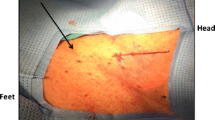Abstract
Malignant chronic bowel obstruction (MCBO) is a syndrome caused by abdomen-pelvic diffusion of neoplastic diseases of any origin. It generally occurs in an advanced disease, affecting 3–15% of patients recently operated, untreated, or submitted to radiotherapy. Patients complain of chronic pain and vomitus. The approach to this problem is multidisciplinary, involving the surgeon, the endoscopist, the oncologist, and the pain-therapy expert. Direct percutaneous jejunostomy (DPEJ) using a percutaneous endoscopic gastrostomy (PEG) tube is a jejunal percutaneous access procedure indicated for nutrition in those patients whose stomach cannot be used, as in cases of partially or totally gastrectomized ones. A venting PEG or percutaneous endoscopic jejunostomy (PEJ) is a solution to drain the gastrointestinal tract for MCBO even in difficult cases represented by patients with previous abdominal surgery, those with partial or total gastrectomies, ascites, or peritoneal carcinosis. We report our five-case experience of draining an MCBO in patients previously operated on for gastric cancer, using a DPEJ technique that we believe is the best technique for this purpose.


Similar content being viewed by others
References
Cannizzaro R, Bortoluzzi F, Valentini M, Scarabelli C, Campagnutta E, Sozzi M, Fornasarig M, Poletti M (1995 ) Percutaneous endoscopic gastrostomy as a decompressive technique in bowel obstruction due to abdominal carcinomatosis. Endoscopy 27:317–320
Gauderer MW (2002) Percutaneous endoscopic gastrostomy and the evolution of contemporary long-term enteral access. Clin Nutr 21:103–110
Gorman CR, Morris JB (1997) Minimally invasive access to the gastrointestinal tract. In: Rombeau JL, Rolandelli RH (eds) Enteral and tube feeding, 3rd edn. Saunders, Philadelphia, pp. 189
Hünerbein M (2004) Endoscopic and surgical palliation of gastrointestinal tumors. Support Care Cancer 12:155–160
Karpeh MS, Kelsen DP, Tepper JE (2001) Cancer of the stomach. In: De Vita Jr VT, Hellman S, Rosenberg SA (eds), Cancer principles and practices of oncology, 6th edn. Lippincott, Philadelphia, pp 1092–1126
Lau PWK, Lorentz TG (1993) Results of surgery for malignant bowel obstruction in advanced, unresectable, recurrent colon cancer. Dis Colon Rectum 36:61–64
Piccinni G, Angrisano A,Testini M, Bonomo GM (2004) Definitive palliation for neoplastic colonic obstruction using enteral stents: personal case-series with literature review. World J Gastroenterol 10:758–764
Ripamonti C, Twycross R, Baines M, Bozzetti F, Capri S, De Conno F, Gemlo B, Hunt TM, Krebs HB, Mercadante S, Schaerer R, Wilkinson P (2001) Clinical practice recommendations for the management of bowel obstruction in patients with end-stage cancer. Support Care Cancer 9:223–233
Scheidbach H, Horbach Th, Groitl H, Hohenberger W (1999) Percutaneous endoscopic gastrostomy/jejunostomy (PEG/PEJ) for decompression in the upper gastrointestinal tract. Surg Endosc 13:1103–1105
Shike M, Schroy P, Ritchie MA, Lightdale CJ, Morse R (1987) Percutaneous endoscopic jejunostomy in cancer patients with previous gastric resection. Gastrointest Endosc 33:372–374
Shike M, Latkany L (1998) Direct percutaneous endoscopic jejunostomy. Gastrointest Endosc Clin N Am 8:569–580
Stellato TA, Gauderer MW (1987) Percutaneous endoscopic gastrostomy for gastrointestinal decompression. Ann Surg 205:119–122
Stellato TA, Gauderer M W Ponsky J L (1984) Percutaneous endoscopic gastrostomy following previous abdominal surgery. Ann Surg 200:46–50
Tapia J, Murguia R, Garcia G, Espinoza de los Monteros P, Oñate E (1999) Jejunostomy: techniques, indications and complications. World J Surg 23:596–602
Vargo JJ, Germain MM, Swenson JA, Harrison CR (1993) Ultrasound–assisted percutaneous endoscopic gastrostomy in a patient with advanced ovarian carcinoma and recurrent intestinal obstruction. Am J Gastroenterol 88:1946–1948
Author information
Authors and Affiliations
Corresponding author
Rights and permissions
About this article
Cite this article
Piccinni, G., Angrisano, A., Testini, M. et al. Venting direct percutaneous jejunostomy (DPEJ) for drainage of malignant bowel obstruction in patients operated on for gastric cancer. Support Care Cancer 13, 535–539 (2005). https://doi.org/10.1007/s00520-004-0749-4
Received:
Accepted:
Published:
Issue Date:
DOI: https://doi.org/10.1007/s00520-004-0749-4




